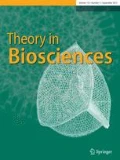Summary
The paper aims at a systematic approach to the self-organization of behavior. It is rooted in the ideas of situated artificial intelligence and introduces situated behavior as the target for the self-organization procedure. Based on a quantitative measure of behavioral situatedness a learning dynamics is introduced which enables the controller to sustain the situatedness of the agent. The principle is demonstrated with Khepera robots in a number of different environmental conditions.
Similar content being viewed by others
References
Arkin, R. C. (1998) Behavior Based Robotics. MIT Press.
Cannon, W. B. (1939) The wisdom of the body. Norton, New York.
Der, R., Steinmetz, U. and Pasemann, F. (1999) Homeokinesis - a new principle to back up evolution with learning. In M. Mohammadian, editor, Computational Intelligence for Modelling, Control, and Automation, volume 55 of Concurrent Systems Engineering Series, pages 43–47. IOS Press.
Nolfi, S. and Floreano, D. (2000) Evolutionary Robotics. MIT.
Pfeiffer, R. and Scheier, C. (1999) Understanding Intelligence. MIT Press.
Author information
Authors and Affiliations
Corresponding author
Rights and permissions
About this article
Cite this article
Der, R. Self-organized acquisition of situated behaviors. Theory Biosci. 120, 179–187 (2001). https://doi.org/10.1007/s12064-001-0017-9
Issue Date:
DOI: https://doi.org/10.1007/s12064-001-0017-9




